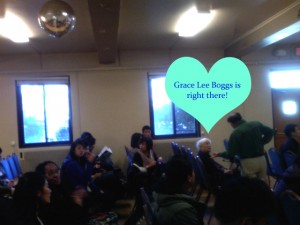Glenn Omatsu
I was trained in a community situations; education is possible everywhere. Anything can be come education. Education is life. It can be transformative. I don’t know if I would think and be this way had I gone through traditional forms of education.
This vision fuels current Ethnic Studies conference.
Wasn’t until junior year in college and into organizing in San Francisco; anti-imperalism orgs, Japanese newspaper, early life was infused with “how do you raise awareness, how to do you engage people?’
You don’t need books or a classroom, but you need desire and intention.
My way of teaching is infused with workers’ experiences because I worked with labor unions; my style of education is informed by my experiences.
You need a spirit of experimentation to educate; it may or may not be successful. One thing that works with one group may not work with another group.
Western concept of education: sit in an audience and not participate.
— explaining interactive exercise that is coming up —
Culture circle — culture means community that you’re involved in, not just race or ethnicity.
I focus on holistic learning, focuses on the mind, not separating thinking and doing.
Talk about something in your possession that reveals something about your culture. Culture is much more than ethnicity and race. I do this to humanize the class. To get to know other people as human.
SE Asians academic class right now is about broadening the discussions beyond criticisms of communism and government. — points to student writing on a wordpress blog
–more interactive exercises —
identify one struggle. create a small educational activity that refers to the issue that you chose. brainstorm teaching activities and ideas to share. suggestions: organize and write a song, a rap, perform a play, a comic strip, haiku poetry, mini mural making, write a poem.
the objective: to overcome western colonial culture which says you have to know before you act, separates thinking from doing, separates teaching and learning.
Strategies to Overcome Westernized Concepts of Education
(my group went first)
we made a digital mural of our faces (taken with my webcam) and then aligned them in a line going down the middle of the mural wall and on the left side put OLD and on the right put NEW and then opened a dialogue about what would be the new issues presented to Asian Americans now that Asians before did not and the nuanced ways that unite and differentiate Asian Americans and Asians.
map out the journey of food in your family (analysis of skyrocketing rates of obesity and diabetes in certain cultures) particularly for our race. Food is powerful educational tool. “Feast of Resistance” curriculum by ?? to teach history in an informative and cultural kind of way using food items.
— next group asks out skit — trying to promote cultural awareness cross lines of latin@ and asian difference (deportation, food, cultural appropriation)
Next group: raising consciousness — do lines of poetry; pass one piece of paper with the line:
I am
I struggle
and have each person fill out. (reading poem that the group did as an example — it’s awesome by the way)…
This exercise helps younger people who don’t identify as poet or writers. This could empower them to rethink that concept and gets people to express themselves publicly.
How to raise consciousness and how to frame issues. Each person write about the issue they are facing and then pass/share with others in the group. You take someone else’s issue back to our community and discuss.
Use the sketch/phrase See, Hear, Speak No Evil and use as a base to ask what you are doing and how are you using your senses.
Next group: exercise to unpack privilege and power. Everyone stands in a line. Ask series of questions. Take a step forward if…parents graduated from college, speak english, primary identity is caucasion/White.
Take a step back if you went to bed hungry, or are a woman or a person of college, if you grew up around prostitution or drugs.
End of game everyone is dispersed through the room. Then you conduct race to see who can reach the wall fastest and the person who is usually up front will win. So, no matter how fast or strong you are, sometimes its not enough with the system but with determination you always reach the wall no matter what.
You can take the same activity and adapt — make use for racial equality, gender bias, etc.
Next group: take cameras and photo document what matters most to you. each person what is is of value and then relate to anti-tobacco use among Asian americans, especially vietnamese population. connect to second hand smoke as well.
Next group: issue is mentoring. concern with working with students around issues of advocacy and getting students involved, resisting apathy. How to address apathy: mentors should not intervene with telling people how to do it. But organize and gather the apathetic and lead them in group discussions on what is important and implement creative strategies to move them from apathy to activism. (use creativity: hip-hop, photography, writing, etc)
Next group: issue how to define asian american issues based on your identity when you are halved
conduct groups arranged by race and then have them list what the issues are that are most pressing and have one group that is mixed. compare the results.
Concluding remarks by Omatsu:
education should be fun. think creatively. it’s invigorating to work with other people even when you don’t know them. it’s best to be with other people. this is based on longer traditions on older asian american communities, similar to other oppressed communities ‘ approach to learning and education. as we move into mainstream thinking, don’t forget your roots about people-centered education. most powerful form of education is outside the classroom. as a teacher, experiment and do something beyond lecture and books. get people outside and do other things in experiementation. this will encourage colleagues to do the same and entire classes and orgs can change in powerful ways.


